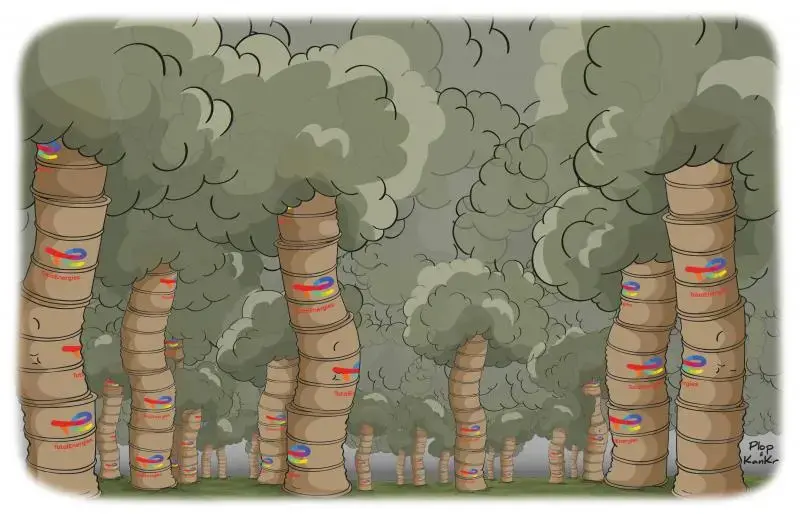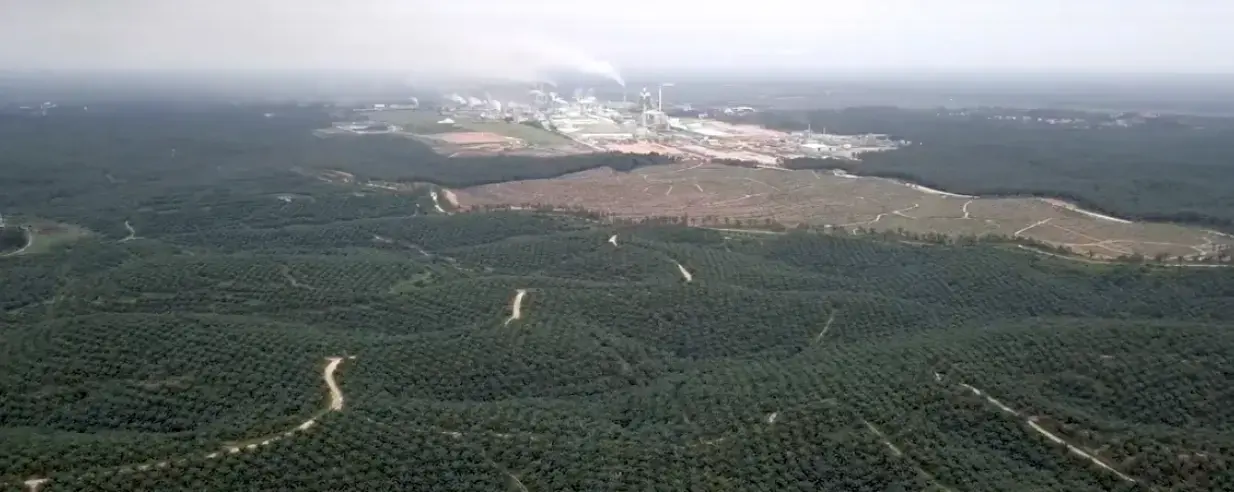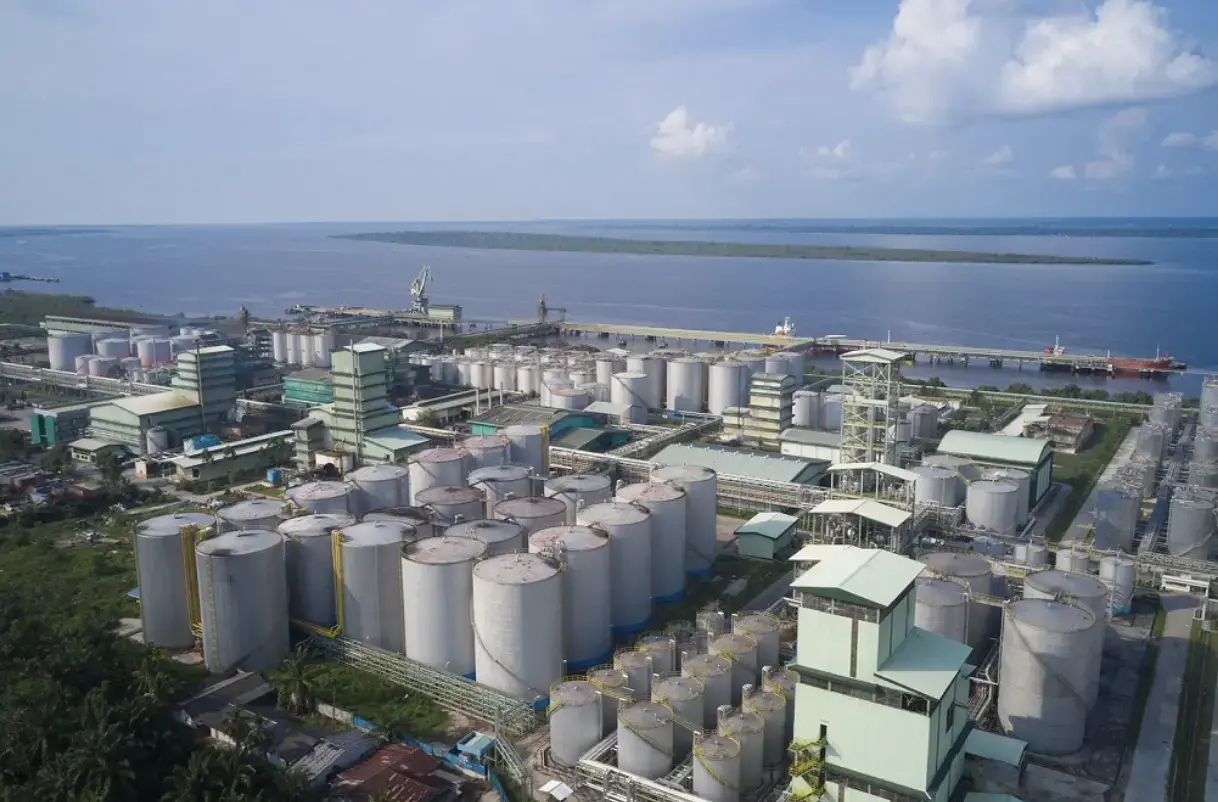
An EU directive is set to ban the import of palm oil for use as biodiesel. In the meantime, diesel continues to be produced from oil deriving from plantations that replaced virgin forest. A good illustration is provided by ENI and TotalEnergies in Indonesia.
Italy's ENI and France's TotalEnergies (like all European biofuel producers) have long passed off diesel made from palm oil from deforested land as "environmentally friendly", hiding behind its legal certification. Not for nothing did the European Parliament votein early October 2022 for an immediate ban on palm oil imports for this purpose.
We have obtained information that unmasks the methods of these two energy giants which together operate a huge number of petrol stations in Europe—and particularly in Italy, Europe's third largest producer of biodiesel after Germany and Spain.
Technically, the biodiesel sold by the two companies complies with the EU’s certification system. Since 2009, this has required member states to replace fossil fuels with an increasing share of eco-fuels to combat global warming (14% for transport by 2030). It is precisely this mechanism that has allowed multinationals to continue to import palm oil without guaranteeing its environmental sustainability, even thought that guarantee is theoretically required by other EU legislation.
One third of the forests lost
In this way, the EU has ended up stimulating the demand for palm oil to produce biodiesel. Thus, have tropical jungles been converted into oil palm plantations, adding to carbon emissions. Because of palm oil, about one third of Indonesia's forests have been lost over the past twenty years. Almost 50% of Europe's palm-oil supply comes from Indonesia.
To remedy this disastrous "rebound effect," in 2018 the EU decided to remove palm oil from the list of renewable energy sources. However, this ban was only to take effect in 2023, with a definitive phase-out delayed until 2030. Until then, palm oil can still be certified as sustainable as long as it does not come from areas deforested after 2008.
ENI and TotalEnergies announced that they would no longer use the fuel as of autumn 2022. For the past four years, however, they have continued to import it (more than 1 million tonnes for ENI), certifying it according to the so-called "mass balance" (1). This is an accounting method that the EU has officially recognised in order to help businesses. Alas, the method contradicts the very principle of sustainability. This system is appreciated by producers for its efficiency. But it does not allow the same level of traceability as a "segregated" system, where raw materials are physically separated throughout the production and transport process. This is why many environmental organisations consider it to be folly, as we shall see.

To unravel the accounting trick, we have followed the entire supply chain back to its source—from the biorefineries where ENI and TotalEnergies transform palm oil into biodiesel—respectively in Gela and Porto Marghera in Italy and La Mede in France—to the plantations where the palm fruits are harvested to produce the oil. The two companies import significant volumes from the same Indonesian refinery Sari Dumai Sejati, which belongs to the Apical Group, one of the world leaders in the sector.
ENI also sources its oil from refineries belonging to at least four other producers operating in Indonesia. The local refineries process the crude oil supplied to them from a number of mills, where the fruits are pressed and macerated. From the mills, each refinery receives certified batches of oil, i.e. from verified plantations, alongside batches of more dubious origin—i.e., from plantations situated on land deforested after 2008.
In the same tanks
However, this separation by the mill is more theoretical than real. In practice, all the batches are often poured into the same tanks before their delivery to the refinery. The cargo from Sari Dumai Sejati that arrives on ships at ENI and TotalEnergies is thus a blend of certified and non-certified portion palm oil (the latter of which is probably the product of deforestation).
The same applies to the oil that ENI buys from other Indonesian refineries. Yet the “mass balance” criterion makes this whole fudge irrelevant. For according to this principle, what matters for certification is the proportion of the oil sent by the refinery that was originally acquired from individual mills that were certified.
Thus, for instance, if the refinery processes 3 tonnes of certified sustainable oil from a first mill, 2 tonnes of certified sustainable oil from a second mill and 5 tonnes of non-certified oil from a third mill, it produces 10 tonnes in total. If a European company imports 5 tonnes of oil from this refinery, it can claim that, according to the mass balance principle, this equates to 2.5 tonnes of certified sustainable oil, when in fact these 5 tonnes might not contain a single drop of certified sustainable oil.
For ENI and TotalEnergies, demonstrating this equivalence is enough to be awarded the green label by the national certification bodies (Rina in the case of ENI). No matter that their biodiesel also contains, in reality, palm oil from deforestated land.
International Sustainability and Carbon Certification (ISCC), the body that developed and runs the Europe-wide certification system, says that the national validation would be wrong to "suggest that the product [contains] a sustainable physical origin," i.e. palm oil exclusively produced from fruit harvested in areas that have not been subject to deforestation. Already in 2020, the Italian consumer-protection authority had sanctioned ENI with a fine of 5 million for misleading advertising, thus forcing it to stop promoting its "Green Diesel."
Non-certified oil
We discovered that the imports declared as green by ENI and TotalEnergies correspond to only a small fraction of the production of the hundreds of mills supplying the Sari Dumai Sejati plant. Most of these mills do not have certified oil, i.e. oil that can be traced back to certified plantations.

To confirm this, we only had to cross-reference the names of the few mills indicated by ENI and TotalEnergies with the full lists on Apical's website and ISCC's certification records. The sustainability assessment of the two companies' biodiesel therefore does not take into account the entire flow of oil that is channelled to Sari Dumai Sejati, much of it from mills connected to plantations that are not subject to any kind of control.
An investigation conducted by the French section of Greenpeace, published in February 2021, estimated that the non-certified oil produced by all the mills in Sari Dumai Sejati had caused the loss of almost 3,200 hectares of forests, peat bogs, and shrubland since 2008. This destruction would have released more than 1.2 million tonnes of CO2. If this data were to be considered, one might wonder whether the two companies' biodiesel would still achieve the minimum CO2 savings of 50 per cent compared to their fossil-fuel equivalent—as the EU rules require it to.
When we asked ENI about this, it merely reiterated that "the certification system guarantees the quantity of oil produced in response to demand [...] that is fully certified". ENI did not deny that the "quantity" of oil means the proportion formally calculated by the "mass balance" mechanism—rather than by the actual quantity delivered to the company. A system based on traceability and separation of palm-fruit flows from the early stages of production would be a better guarantee of truly "green" biodiesel.
Click here to view an interactive map tracking palm oil's travel from deforested areas to pump stations.









